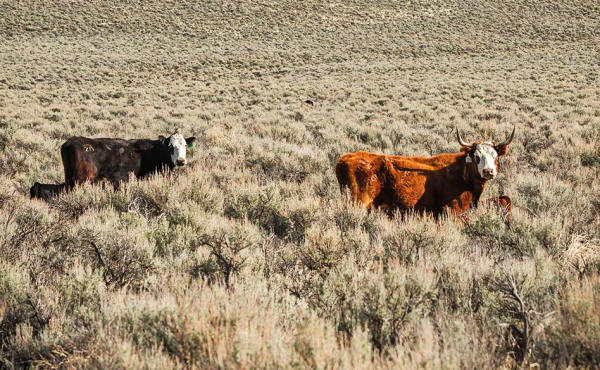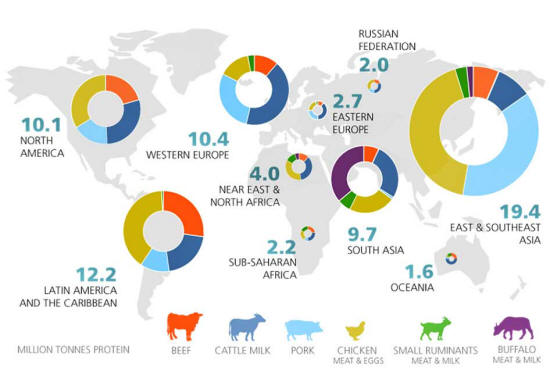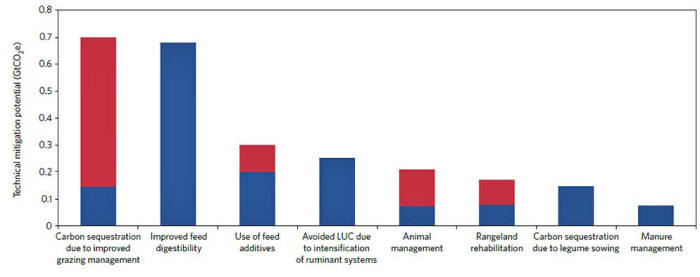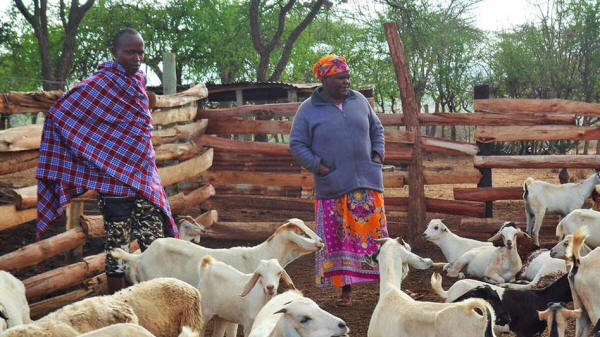|
from
TheConversation Website near Steens Mountain, Oregon.
BLM/Greg
Shine, CC BY
Advocates urge the public to eat less meat to save the environment. Some activists have called for taxing meat to reduce consumption of it. A key claim underlying these arguments holds that globally, meat production generates more greenhouse gases than the entire transportation sector.
However, this claim is
demonstrably wrong, as I will show. And its persistence has led to
false assumptions about the linkage between meat and
climate change.
However, foregoing meat and meat products is not the environmental panacea many would have us believe.
And if taken to an
extreme, it also could have harmful nutritional consequences.
Global livestock production by region (milk and eggs expressed in protein terms). FAO, CC BY-ND
For example,
a 2009 analysis published by the
Washington, D.C.-based
Worldwatch Institute asserted that
51 percent of global
GHG emissions come from rearing and
processing livestock.
All of agriculture accounted for a total of 9 percent. All of animal agriculture contributes less than half of this amount, representing 3.9 percent of total U.S. greenhouse gas emissions.
That's very different
from claiming livestock represents as much or more than
transportation.
In 2006 the United Nations Food and Agriculture Organization (FAO) published a study titled "Livestock's Long Shadow," which received widespread international attention.
It stated that livestock produced a staggering 18 percent of the world's greenhouse gas emissions.
The agency drew a startling conclusion:
This latter claim was wrong, and has since been corrected by Henning Steinfeld, the report's senior author.
The problem was that FAO
analysts used a comprehensive life-cycle assessment to study the
climate impact of livestock, but a different method when they
analyzed transportation.
Instead, they only considered the exhaust emitted by finished cars, trucks, trains and planes.
As a result, the FAO's comparison of greenhouse gas emissions from livestock to those from transportation was greatly distorted.
for reducing greenhouse gas emissions from the livestock sector. Red bars represent the potential range for each practice. Herrero et al, 2016, via Penn State University,
CC
BY-NC-SA
To its credit, the FAO immediately owned up to its error. Unfortunately, the agency's initial claim that livestock was responsible for the lion's share of world greenhouse gas emissions had already received wide coverage.
To this day, we struggle
to "unring" the bell.
However, as Steinfeld has pointed out, direct emissions from transportation versus livestock can be compared and amount to 14 versus 5 percent, respectively.
But according to one recent study, even if Americans eliminated all animal protein from their diets, they would reduce U.S. greenhouse gas emissions by only 2.6 percent.
According to our research
at the University of California, Davis, if the practice of
Meatless Monday were to be adopted by all Americans, we'd see a
reduction of only 0.5 percent.
According to the FAO's
statistical database, total direct greenhouse gas emissions from
U.S. livestock have declined 11.3 percent since 1961, while
production of livestock meat has
more than doubled.
In 2015, average annual
per capita meat consumption in developed countries was 92 kilograms,
compared to 24 kilograms in the Middle East and North Africa and 18
kilograms in Southeast Asia.
In developing countries, raising livestock such as these goats in Kenya is an important source of food and income for many small-scale farmers and herders.
Loisa Kitakaya, CC BY-SA
The value of animal
agriculture
Many critics of animal agriculture are quick to point out that if farmers raised only plants, they could produce more pounds of food and more calories per person.
But humans also need many
essential micro- and macronutrients for good health.
Raising livestock is a
way to add nutritional and economic value to plant agriculture.
According to the FAO, as
much as 70 percent of all agricultural land globally is range land
that can only be utilized as
grazing land for ruminant
livestock.
Feeding this many people will raise immense challenges. Meat is more nutrient-dense per serving than vegetarian options, and ruminant animals largely thrive on feed that is not suitable for humans.
Raising livestock also
offers much-needed income for small-scale farmers in developing
nations. Worldwide, livestock provides a livelihood for 1 billion
people.
These, combined with a rapidly rising world population, give us plenty of compelling reasons to continue to work for greater efficiencies in animal agriculture.
I believe the place to
start is with science-based facts...
|





